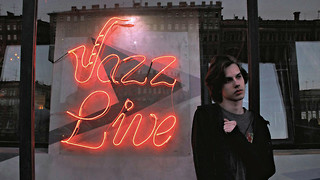Publicity: the art of enticement
Harry Stockwell talks about the lesser known art form of publicity design

Publicity design is a creative form with a real-world purpose; getting you out of your dark corner of the library, or, to you prelim-ers out there, off the backs and into the theatre. And this is not to mention the many other societies and social events vying for your time and attention. Out of this competitive world comes the ubiquitous publicity poster, acting as the theatre’s shop window, reaching out of the ADC or college drama venue into the streets and colleges of Cambridge. All the world may very well be a stage, but our aim is to get you to watch the players on our stage, and pay for the privilege. Driven by this central purpose, the design process is a highly creative and collaborative activity.
This collaborative element is vital to the production of theatre in general, ensuring that the set, lighting, costume, props, music, sound effects and publicity all fit with how the director envisages their interpretation of the script, and making sure that it is all delivered on time. For me, the process of creating a poster to advertise a play therefore must revolve around the director’s brief. Although the director may sometimes need reminding what the right answer is, to ignore their wishes completely would leave an incoherent poster and a surprised audience. In my most recent design, for the Fletcher Players’ production of Lovesong by Abi Morgan (which is on at the Corpus Playroom in Week 7 – I’m not one to miss a publicity opportunity!), the director stressed the play’s focus on sentimentality and memory. We initially worked with the idea of a vintage-look collage but following further drafts and consultation (and a little convincing that I was right!) the theme of personal memory was simplified into the ripped strips of paper and handwritten font that you see on the final design.
I think it is hard to see yourself developing a style, but looking back on the four posters I have designed since entering the ADC for the first time in Michaelmas it is clear that I like to work around a single motif at the centre of the design. There is no need for psychological tricks in publicity design because, after all, the poster must be a true representation of the play. To fool an audience into buying tickets to see a play through false advertising will only result in dissatisfied customers who are unlikely to give recommendations to their friends or return themselves to see another production. The only mind-game I play is to create a strong and memorable image that can act as an easily identifiable logo for the play, something that is becoming increasingly important due to the profile picture culture of advertising on social media. For example, in my freshers’ show, The Penelopiad, this was the simple, if a little haunting, motif of a noose. There’s nothing like the promise of death to get the punters in.
It is testament to the enthusiasm in student theatre to get people involved that I managed to fall into publicity design by accident. It is difficult to substantiate claims of cliquiness when I was asked to do a job that I didn’t really apply for! Publicity design offers a way of getting involved in Cambridge theatre without giving up half your life, and if you would like an opportunity to try your hand then be sure to sign up to the weekly designers’ list at the CUADC website and apply to publicise a show. We could be seeing your flyer in our pigeonholes any time soon.
 News / Cambridge scholarship recipient trapped in Gaza21 July 2025
News / Cambridge scholarship recipient trapped in Gaza21 July 2025 News / Chancellorship candidates express concern about conduct of election 19 July 2025
News / Chancellorship candidates express concern about conduct of election 19 July 2025 News / News in Brief: Chaucer, coffee-houses, and challenging degrees20 July 2025
News / News in Brief: Chaucer, coffee-houses, and challenging degrees20 July 2025 News / Trinity exam burglar jailed for 11 months18 July 2025
News / Trinity exam burglar jailed for 11 months18 July 2025 News / Write for Varsity this Michaelmas13 July 2025
News / Write for Varsity this Michaelmas13 July 2025







